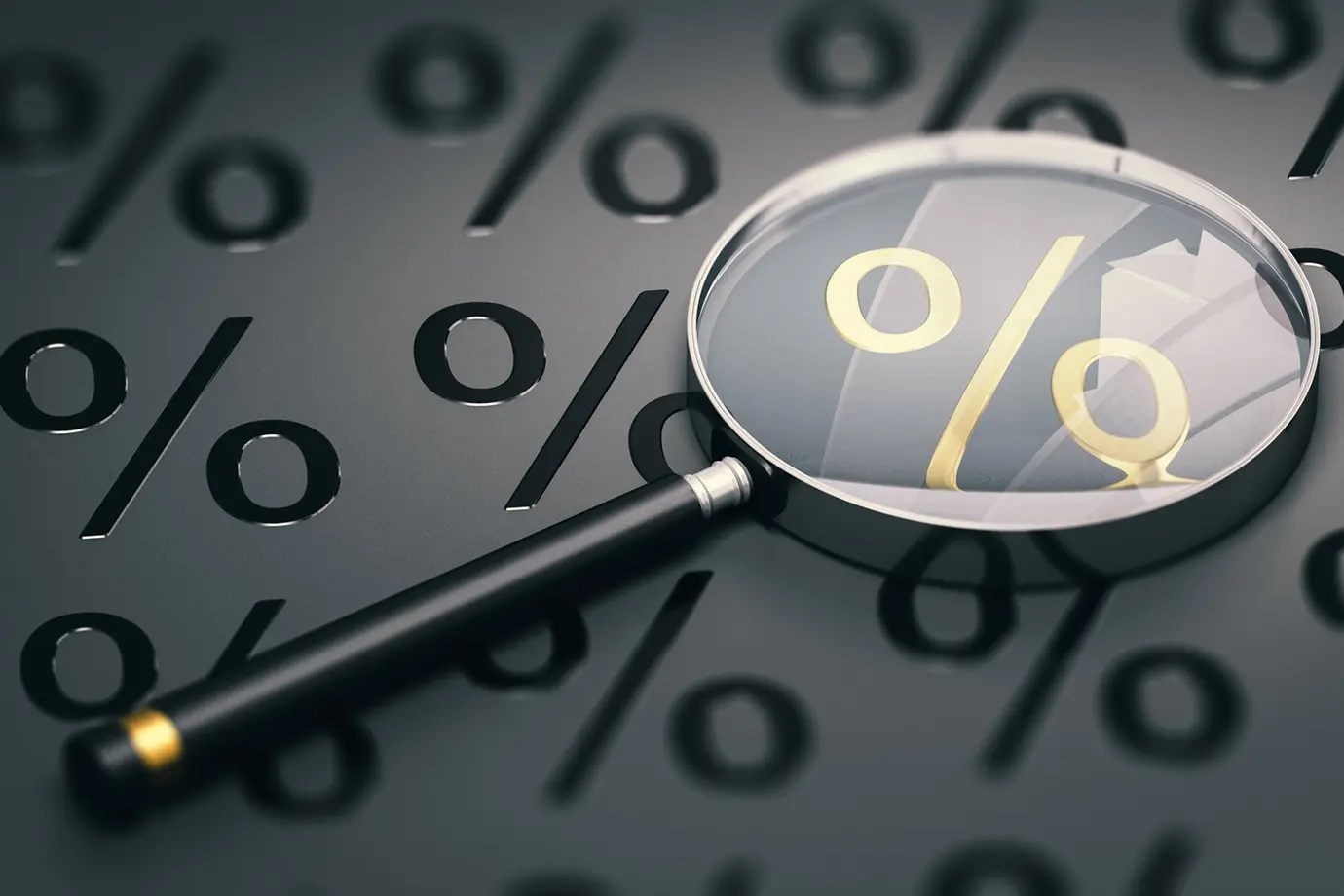On This Page:
How Are Interest Rates Calculated?
Interest Rate Vs. APR: Main Differences

Pre-Qualify With No Impact On Your Credit Score
Facing personal finance feels like hopping into a big maze, right? It may feel tricky, especially when dealing with loans or credit and hearing words like “interest rate” and “APR.” These two words might sound similar, but they aren’t
This article is going to make those tricky banking words easy for you. We’ll explain everything about interest rates and APR so that you can make smart money decisions. We aim to simplify the hard-to-understand world of loans and credits for you. So, let’s jump right into details about interest and annual percentage rates to make dealing with money matters easier.
Key Takeaways
- The interest rate determines how much interest you will pay on your mortgage. The interest rate plus any additional fees is the annual percentage rate (APR).
- Interest rates are determined by various factors, including your credit score, the lender you use, inflation, and the economy.
- When evaluating loan offers, compare the annual percentage rate to gain a more complete view of the actual cost of financing.
What Is Interest Rate?
An interest rate is the cost of borrowing money or the return on investment for lending money, expressed as a percentage. It is a critical financial concept that is crucial in various economic activities. When you borrow money, such as taking out a loan or using a credit card, the interest rate represents the percentage of the loan amount you need to pay back in addition to the principal (the original amount borrowed).
Think of it this way: when you put money in a savings account or invest, what you earn over time hinges on the interest rate. Now, many things shape these rates. Things like what the central bank decides, inflation, the state of the economy, and how risky it seems to lend or borrow money.
Let’s talk about two essential kinds of interest rates – nominal and real. The nominal rate is like the label on a loan or investment. It says what the rate should be. But, the actual rate goes further. It changes the nominal rate to consider inflation. So, it gives an accurate picture of how much you’ll be able to buy with your money.
Interest rates significantly impact individual and business financial decisions, influencing spending, saving, and investment patterns in the economy. They are closely monitored by policymakers, investors, and consumers alike due to their far-reaching implications on overall economic health.
How Are Interest Rates Calculated?
The interest rate is figured out by looking at different factors. These factors show how much it costs to borrow money or how much money lenders make. Here are the essential parts:
- Guideline Rates: Banks like the Federal Reserve in the US set the loan rates. These rates shape the general rates environment. For example, the federal funds rate set by the Federal Reserve is a guide for many other rates.
- Credit Risk: Lenders look at how likely borrowers can repay the money. Those with a higher risk of not paying back may be charged a higher interest rate. It makes up for the chance they might not pay back the money.
- Inflation: Inflation makes money worth less over time. Lenders look at predicted inflation rates when they set interest rates. It helps them keep the actual worth of their returns. Usually, it may happen with payday loan charges and mortgage interest rates.
- Market Conditions: The amount of credit wanted and the amount available influences interest rates. If more credit is desired, the interest rate might go up, and vice versa. Conditions like how many people are jobless and how strong the economy is also matter.
- Liquidity Premium: Some investments or loans are harder to sell, meaning they are less liquid. It means a higher return is needed to make up for the difficulty in selling.
- Government Policies: Government policies and regulations can impact the interest rate. For instance, central banks may adjust rates to stimulate or cool down economic activity.
What Is APR?
The annual percentage rate (APR) is a tool we use to see how much a loan costs in a year. It tells us the interest rate and any extra fees we must pay. It helps us understand how much we must repay if we take out a loan or use a credit card.
The APR adds fees and extra costs so that we know the truth about a loan’s price. When lenders tell us the APR, we can see which loans are cheaper or more expensive. APR is like a helper for smart money choices. It keeps things clear and helps us compare the cost of credit products.
How Is APR Calculated?
Lenders must calculate the annual percentage rate, principal loan amount, monthly payments, and other closing costs when borrowing money. But here is how they calculate the loan’s APR:
- Base Loan’s Interest Rate: Simply put, it’s the maximum interest rate a bank charges you yearly for the loan.
- Extra Costs: The APR factors add costs to your loan, like origination fees, closing costs, and other broker fees. They are piled onto the base interest rate for a fuller view of your loan costs.
- Loan Time: How long is your loan? Well, the duration affects the interest rate and the APR. Long-term loans tend to carry a higher APR because the total interest rate piles up over time.
- Interest Compounding: The frequency of interest compounding – how often it’s added to the loan – counts, too. It can be monthly, quarterly, or something else, and it tweaks the APR.
A set formula brings together these elements to figure out the APR. The formula looks at cost across the loan’s lifespan, including interest and additional fees. The goal is to offer a true measure of the loan cost.
Interest Rate Vs. APR: Main Differences
The APR and interest rate are often misunderstood. An interest rate is what it costs to borrow money. It’s a percentage of the cash you borrowed. It is the price tag most banks will show you.
APR, or annual percentage rate, however, tells a broader story. Besides the interest rate, it includes costs like origination fees, points, and closing fees. The APR represents the actual yearly cost of your loan.
Interest rate only focuses on the interest part; APR covers the total cost of your loan. It’s like comparing the price of an apple versus the cost of your entire grocery. One should consider the APR and interest rate before taking a personal loan or any other loan product to make wise money choices. If you’re lucky enough, you may receive some discount points to decrease the loan’s interest rate and APR and get an affordable loan.
How to Compare Interest Rates vs. APRs?
The comparison APR vs. interest rate has different parts. Interest rates show the borrowing cost as a percent of the loan. APR shows the interest rate plus other loan fees and charges. Follow these steps to compare interest rates and APRs:
- Find the Interest Rate: Look for the loan’s listed interest rate. This percentage shows the cost of borrowing the principal loan amount.
- Learn about APR Parts: APR includes the interest rate and additional fees like origination fees, points, and more. These fees add to the total loan cost.
- Check Similar Loans: Compare interest rates and APRs for the same loans. It means the loan amount, payback period, and loan type. It gives a fair comparison of APR vs. interest rate.
- Consider Fee Impact: Think about extra fees in the APR. More fees make a higher APR. So, if the interest rate is reasonable, check if these fees make sense with the loan terms and monthly payments.
- Prepare for Changing Rates: If working with shifting interest rates, remember that APR might change as the rate moves. Think about possible rate changes when looking at the loan’s long-term cost.
- Look for Early Payment Fines: Understand if there are any early payment fines with your loan. If you aim to pay your loan beforehand, these fines might raise the total cost.
- Think About Your Funds: Look closely at your financial status and wishes. Some may want a lower APR, and some might care more about the immediate costs shown in the interest rate.
- Talk to Lenders: Speak with lenders and ask them to explain any confusing terms or aspects regarding your monthly payment. Speaking openly with loan providers helps you make an intelligent choice about your finances and maybe get some discount points.
The Bottom Line On Interest Rate Vs. APR
In the end, knowing the difference between interest rates and APR for intelligent money decisions is essential. Interest rates show how much it costs to borrow money. But APR? It gives us a more comprehensive view. It includes extra charges and fees. When looking at loan options, don’t just look at one or the other.
Both figures give the actual cost of borrowing. With a clear understanding of interest rates and APR, anyone can feel more sure about money matters. They can make the right decisions to reach their money goals in the long run.

